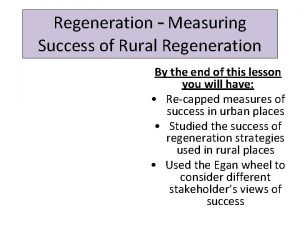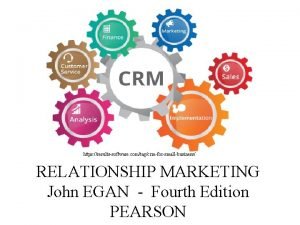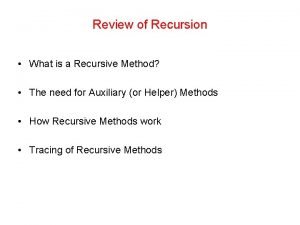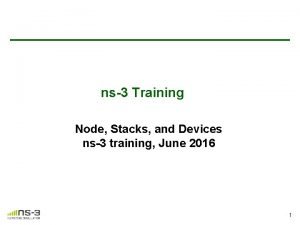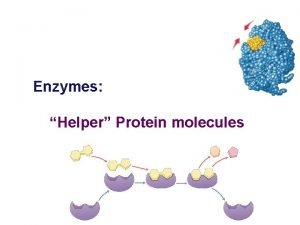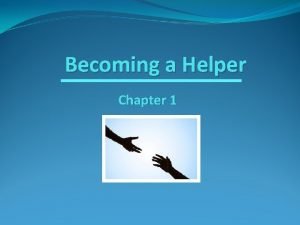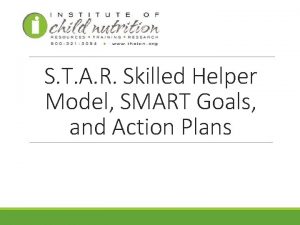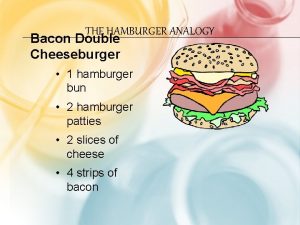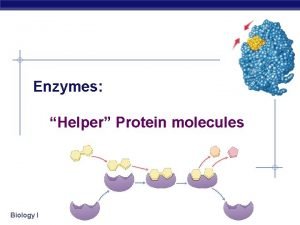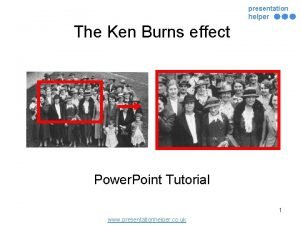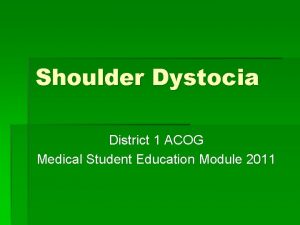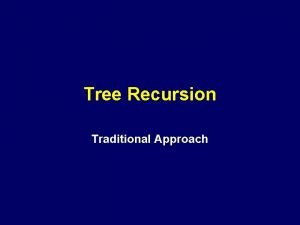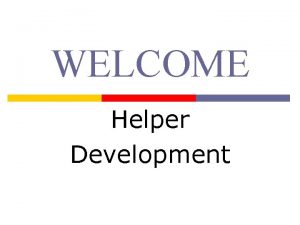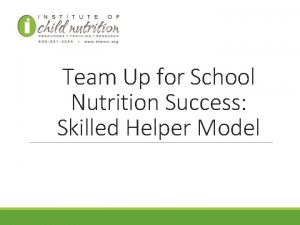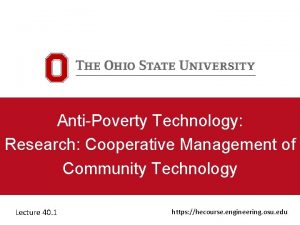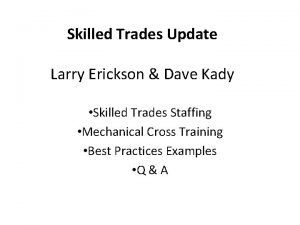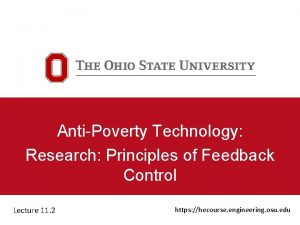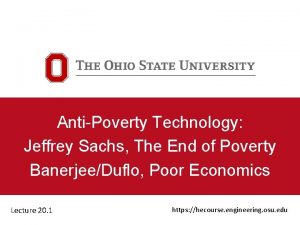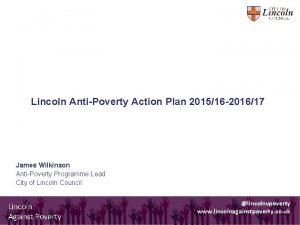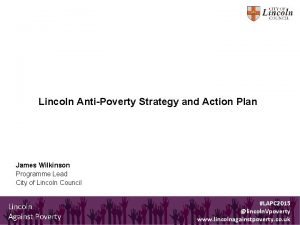AntiPoverty Technology Egan The Skilled Helper Lecture 27




























- Slides: 28

Anti-Poverty Technology: Egan, The Skilled Helper Lecture 27. 1 https: //hecourse. engineering. osu. edu

Prof. Gerard Egan • Professor Emeritus of Organization Development and Psychology in the Quinlan School of Business at Loyola University, Chicago • Author of 15 books • Here: “The Skilled Helper” (10 th Edition) 2

Client “problem situation: ” • Immediate living conditions (e. g. , their household, community, and impact of environment) • Challenges (e. g. , generating income, getting an education, or accessing healthcare) http: //www. publicdomainpictures. net/ hledej. php? hleda=poverty 3

Helping objectives: • Help the client solve or manage problems by improving their problem situation • Help them identify resources and opportunities, and exploit their own potential https: //pixabay. com/en/reaching-out-helping-cooperation-40805/ 4

Clients say what they want to do about the problem situation: What they want, but with guidance What are the goals, problems to solve: • Important to them • Willing to work on • Primarily client-specified https: //pixabay. com/en/ goal-setting-success-976853/ 5

Helper: • Help client learn to help themselves • Put the client in the “driver’s seat” • Keep goal in mind: “Live-enhancing outcomes” for the client, by the client 6

Helper: • Can help find simple-enough goals/problems • Ones that will give fast (small) success to motivate client and give hope • Ones with immediate benefit/cost ratio >1 so will incentivize • Use an exemplar 7

Help state goals in terms of outcomes: • Specific • Substantive • Prudent • Realistic • Sustainable • Flexible • Congruent with values • Achievable in some time frame http: //www. picserver. org/g/goals. html 8

“Second order goals”⇒second order change • Changing the system rather than only adjusting it • Creating something new • Making change that will endure rather than be prone to collapse • Transforming rather than fixing • Using new learning • Addressing causes rather than symptoms “Substantial, ” “real, ” or “good” change 9

Seeking life-enhancing outcomes is constrained by context: • Problem situation, past successful or failed attempts to change their problem situation and/or employ unused opportunities or resources • Personal history • Expectations, aspirations, and disappointments • Skills and strengths • Hopes and fears 10

• • Openness and readiness for change Willingness to work for change Reluctance or resistance to change Ability and willingness to collaborate with a helper • Sense of right and wrong, ethics, and morality; cultural beliefs, values, and behavioral norms • Existing relationships; Communication skills; Obstacles to change; External factors that support change 11

The effective helper should: • Have good interpersonal skills • Seek to build trust with the client • Seek to establish an agreement with the client on the goals of the helping process • Understand the client and her or his problem situation and can identify causes • Promote client self-challenge • Understand the general cultural, social, economic, and political context of the client 12

• Maintain a flexible stance in helping and can effectively change helping as unexpected situations arise • Competent in helping create candidate solutions and persuasive with suggestions • Can help monitor progress • Sets up feedback methods to monitor progress in change and the helping process • Can help instill hope and optimism; does not avoid the most difficult issues; and is committed to professional self-improvement. 13

Egan: “Helping is a two-person collaborative exercise in creativity” A design team. . . https: //www. jisc. ac. uk/rd/projects/collaboration-to-clarify-the-cost-of-curation-4 c-project 14

Client should be helped to nurture and use their creativity. . . encourage them to: • Generate ideas • Vary existing things to adapt them • Via collaborative brainstorming. • Divergent thinking ⇒ many solutions to a specific problem. Client knows the problem situation best – listen to them! 15

Brainstorming: • Judgment should be suspended • Ideas should be used to generate new ideas, even “wild” ones. • Set of ideas ⇒ down-select • Useful for goal-setting and plan selection (below) https: //www. flickr. com/photos/ creativegem_designs/7088721715 16

Tailoring helping to client, example: Egan: “clients who were mainly from the lower socioeconomic class wanted advice, signs of real interest in their problems, encouragement and reassurance, understanding, and the instillation of hope from their helpers” 17

Helper-client relationship = working alliance Foundation: “flexibility, honesty, respect, trustworthiness, confidence, warmth, interest, and openness” Clients appreciate: “self-presentation and body language, nonverbal gestures, emotional support and care, honesty, validation, guidance, challenging, helper's education, helper's appreciation of client self -responsibility” 18

Helper: • Show respect, do no harm, do not to rush to judgment about the client and their problem situation. • Competent, committed, genuine (e. g. not being a phony by over-emphasizing professional role) • Show that they are “for” the client • Down-to-earth and non-sentimental (e. g. , talk eye-to-eye at their level, not down to them with condescension) • Assume the good will of the client, and always focus on the client's agenda 19

Show respect: • Via empathy, that is, by stepping outside oneself and taking on the client's perspective • Via appreciation of diversity and multiculturalism (keen focus on a person's humanity and dignity) Understand poverty, culture, gender roles, etc. and work with clients the way they are https: //en. wikipedia. org/wiki/Culture_of_Assam 20

Communication skills are important: • • • Paying close attention (“empathetic presence”) Listening (below, “active listening”) Understanding what a client is thinking and saying, • Responding based on good understanding, • Helping a client fully explore concerns and https: //pixabay. com/en/interview focus, and -job-icon-job-interview 1018332/ • “Helping clients challenge themselves to develop new perspectives on their problem situations and unused opportunities” Take turns in speaking: No monologues 21

Helper understanding is based on: “active listening” (empathetic/focused) Poor listening by helper: • Not engaged with the client • Partial listening “skimming the surface” to pick up pieces of what is said) • Gets the words but is not really present • “Rehearsing" a response while the client is talking 22

Focus on the client, organize: • Client experiences • Client points of view and values • Client's intentions, proposals, decisions, and plans • Client strengths, opportunities, and resources. 23

• Integrate client narrative • Probe/question for clarity • Helper summary, client summary Respond: Perceptive, having competence (“know how”), being accurate, being assertive, and considering all issues (client, and problem situation, and context). 24

Standard problem management framework: 1. What is going on? (current picture) 2. What does a better future look like? (preferred picture) 3. How do I get there? (plans/actions, the way forward) 4. How do I make it all happen? (implementation) Client+helper work on all this together 25

Helper role: 1. Use active, empathetic, and focused listening to create a “model” (most often, a mental representation, or ``mental model") of the client, problem situation, and context 2. Use this model to generate responses, suggestions, inputs to the client/process 26

Help or not help (initial screening/later)? • Client appears to be already solving problems on their own • Client has a history of not engaging in the helping process (expecting to have everything done for them) • Client with only minor problems • Client with low commitment (e. g. , if they have other competing agendas from family or job or demands on their time) • Client who simply does not want help 27

Discussion: Helping, Part 1 Your general view of other people can affect whether or not you will help them. In “Rising Strong” (p. 110), Brené Brown asks: Do you think, in general, that people are doing the best they can? 28
 01:640:244 lecture notes - lecture 15: plat, idah, farad
01:640:244 lecture notes - lecture 15: plat, idah, farad Nora egan
Nora egan Emmet egan
Emmet egan Sarto y nipo
Sarto y nipo Helsinki tapahtuma
Helsinki tapahtuma Judge donnelly cook county
Judge donnelly cook county Characteristics of rural area
Characteristics of rural area Brianna egan
Brianna egan Gillian petrie
Gillian petrie Judge lynn egan
Judge lynn egan John egan marketing
John egan marketing Recursive helper method
Recursive helper method Internet stack helper ns3
Internet stack helper ns3 Chrome helper gpu
Chrome helper gpu Librarian community helper
Librarian community helper Helper shoulder dystocia
Helper shoulder dystocia Helper protein molecule
Helper protein molecule Radacad power bi helper
Radacad power bi helper Helper chapter 1
Helper chapter 1 Painter community helper
Painter community helper The holy spirit is the helper
The holy spirit is the helper Helper model 2
Helper model 2 Analogy helper
Analogy helper Helper protein molecule
Helper protein molecule Presentation helper
Presentation helper Help help chapter 1
Help help chapter 1 Helper in shoulder dystocia
Helper in shoulder dystocia Microsoft agent scripting helper
Microsoft agent scripting helper Helper plumber
Helper plumber






